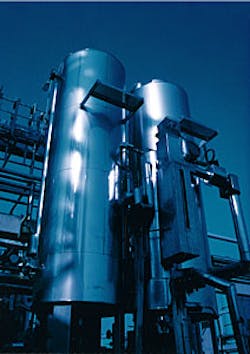Dutch gas plant uses polymer process to treat aromatic-saturated water
At Elf Petroland's gas plant in Harlingen, The Netherlands, this MPPE unit removes aromatic compounds from water after produced natural gas has been dehydrated.A gas-processing plant in Harlingen, The Netherlands, operated by Elf Petroland has been running a porous-polymer extraction process since 1994 to remove aromatic compounds from water associated with produced natural gas.
In the period, the unit has removed dispersed and dissolved aromatic compounds to a concentration of <1 ppm with energy consumption of only 17% that of a steam stripper, according to Paul Brooks, general manager for Akzo Nobel's Macro Porous Polymer-Extraction (MPPE) systems.
Glycol treatment
Harlingen is in the north of Holland on the shore of the Waddensea, a shallow tidal pool connected to the North Sea. Elf Petroland's plant processes 125 MMcfd of offshore gas and generates 700 b/d of water with benzene, ethylbenzene, toluene, and xylene (BTEX) separated in a glycol dehydration unit.The glycol is thermally regenerated in a stripper that yields water containing hydrocarbons. The water/hydrocarbon stream is then separated in the MPPE unit (Fig. 1 [75,703 bytes]); Fig. 2 shows the MPPE unit.
With a relatively constant flow of 16-20 gpm, in-flow concentrations of aromatic hydrocarbons to the MPPE unit typically range 1,000-3,000 ppm with spikes to 10,000 ppm. The variation results from the water and aromatic concentration in the natural gas and covers the range during any given day.
Effluent aromatic hydrocarbon concentrations range from 100 to 1,000 ppb; the effluent is discharged to the city treatment works. Distance from the production wells precludes injection as a disposal option for the associated water, and the small community's treatment plant would be overwhelmed by the large mass loading of aromatic compounds without pretreatment.
Elf Petroland, says Brooks, needed a treatment method that was economical, tolerant of fluctuating flow and contaminant concentration, and rugged and reliable for continuous service in a hostile environment.
Liquid-liquid process
The MPPE process separates hydrocarbons from water by a liquid-liquid extraction process. A patented porous polymer-developed by Akzo Nobel contains an extraction liquid within the pores. The polymer and the extraction solvent are both highly hydrophobic and, as a result, have a strong affinity for nonpolar compounds.Hydrocarbons, dissolved or dispersed in water, partition to the extraction solvent and remain in solution within the polymer pores. A strong attraction to the polymer coupled with an extremely low solubility in water prevents partitioning of the extraction solvent to the water. Thus, a unidirectional extraction mass transfer is accomplished.
MPPE material operates in a packed column. The water/hydrocarbon (raffinate/solute) phase passes in plug flow through an MPPE column and the solute partitions to the solvent.
Very high mass-transfer efficiency is achieved as the declining concentration raffinate/solute front continuously meets fresh solvent in the polymer, the equivalent of many extractors in series. In-flow concentrations of thousands of ppm are reduced to single-digit ppb in a single pass through a single MPPE column.
Over time, says Brooks, the extraction solvent loads with hydrocarbon (Fig. 3 [31,037 bytes]). At this point, the MPPE may be regenerated in situ by stripping the hydrocarbons from the extraction solvent.
Low-pressure steam is introduced into the top of the column. As the polymer heats, the solute is vaporized from the solvent and passes out of the column with the steam.
Again, the strong affinity of the solvent for the polymer, coupled this time with its very low vapor pressure serve to keep the solvent in the polymer pores. The steam and solute are condensed together.
Because the amount of steam required for stripping is very low relative to the amount of water in the extraction step, the concentration of hydrocarbon in the condensate is very high, exceeding saturation which leads to phase separation. The free-phase hydrocarbon is available for beneficial reuse/recycle or disposal.
High purity and low volume facilitate economical disposition of the recovered hydrocarbon. The low-volume, high-concentration condensate is recycled to the MPPE column in a closed loop. Fig. 4 [39,3992 bytes] is a flow diagram of the MPPE process.
Contracts
The specified performance is guaranteed and maintained by Akzo Nobel MPPE Systems, says Brooks. Through a service contract, MPPE Systems' engineers monitor the process and, when the MPPE material appears exhausted, replace the material at no additional cost to the client.Brooks says the cost of an MPPE unit is competitive with other treatment and disposal techniques, including injection.
MPPE units designed to specification can be purchased on the basis of a design-build-perform (DBP) contract. Under this contract, the client has no capital investment, only a single annual payment for a specified number of years.
For natural gas and petroleum-produced water operations, this contract rate will range from $0.003-0.007/gal of water.
The main advantage of the DBP contract, according to Brooks, is that under the guarantee, cost runs with performance. If the system doesn't perform according to specifications, MPPE Systems corrects the problem or all payment stops.
Copyright 1998 Oil & Gas Journal. All Rights Reserved.
